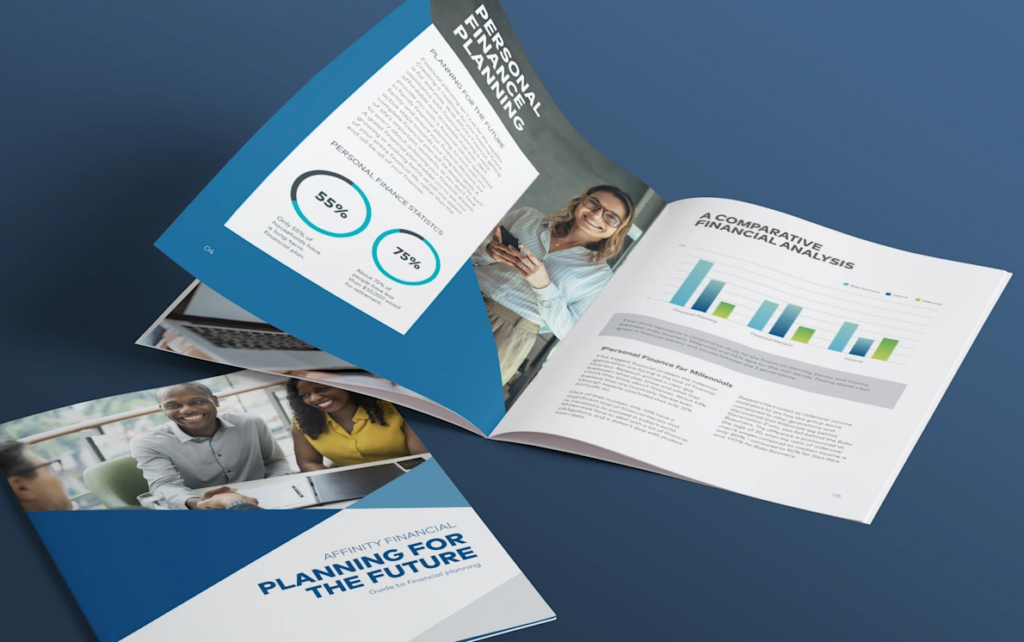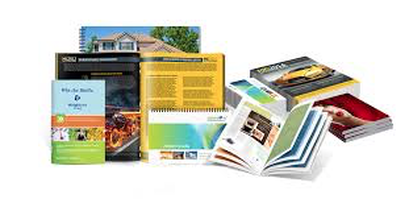What Makes Variable Content So Powerful in Booklet Printing?
The Essential Guide to Understanding Pamphlet Printing Options and Techniques
The procedure of brochure printing includes several factors to consider that can substantially impact the end product. From choosing the suitable format and dimension to comprehending the nuances of binding approaches, each selection plays a crucial function. Additionally, factors such as paper supply and printing methods further affect the efficiency of the pamphlet. As one browses these alternatives, it ends up being necessary to comprehend how they interconnect and what that suggests for the overall result.
Recognizing Booklet Sizes and formats
When thinking about booklet printing, comprehending the numerous styles and sizes offered is important for attaining the desired discussion. Brochures can be generated in various layouts, including saddle-stitched, spiral-bound, and perfect-bound, each offering distinct benefits. Typical dimensions range from typical letter (8.5 x 11 inches) to smaller options like A5 (5.8 x 8.3 inches), enabling for flexibility based on web content and target audience.Selecting the appropriate size can affect both the format and visitor involvement. Bigger sizes might match visually driven material, while smaller sized layouts might be much more mobile and straightforward. Furthermore, the variety of web pages affects the option of binding method, as thicker booklets might call for tougher bindings. Inevitably, understanding these aspects enables a more tailored technique, guaranteeing that the last product aligns with the designated message and visual, boosting the total effectiveness of the communication.
Choosing the Right Paper Stock

Binding Methods: Factors To Consider and alternatives
When it concerns binding techniques for brochures, several choices are readily available, each with distinctive advantages. Saddle stitch binding provides an economical solution for thinner brochures, while best binding strategies provide a more polished look for thicker magazines. Wire-O binding attracts attention for its resilience and simplicity of usage, making it suitable for documents that require flexibility.
Saddle Stitch Binding
Saddle stitch binding provides a functional and economical option for setting up pamphlets, making it a preferred option amongst authors and organizations. This binding technique entails folding sheets of paper in half and stapling them along the fold line, creating a neat and organized appearance. Generally suitable for booklets with a reduced page count, saddle stitching is optimal for magazines, pamphlets, and educational materials. The simpleness of this technique enables for fast manufacturing and is commonly favored for advertising products or short runs. It is essential to keep in mind that saddle stitch binding may not be appropriate for thicker booklets, as the spinal column may not hold up under increased weight. On the whole, it stays a reputable option for many printing tasks.
Perfect Binding Techniques
Perfect binding is an extensively made use of technique that offers a professional and sleek surface to brochures and publications. This method involves gluing the web pages with each other at the spine using a strong adhesive, enabling for a clean edge and the capacity to hold a larger variety of pages compared to saddle sewing. Perfect binding is particularly ideal for thicker booklets, such as magazines and annual records, where a sturdy, flat spinal column is wanted. Furthermore, it supplies the alternative for a printed cover that can be created to boost visual charm. However, considerations such as web page matter, paper weight, and the planned use of the brochure need to be considered, as they can affect durability and general high quality.
Wire-O Binding Options
Wire-O binding, understood for its toughness and adaptability, offers an excellent choice for brochures that need very easy web page transforming and an expert look. This binding approach utilizes a collection of steel loopholes that hold web pages firmly, permitting them to exist level when open. It is specifically ideal for brochures, discussions, and handbooks as a result of its durable nature. Wire-O binding is offered in various shades and sizes, accommodating various page counts and thicknesses. Furthermore, it allows the inclusion of tabs and covers, enhancing the brochure's general visual. Considerations for Wire-O binding include the choice of cable shade, the size of the loopholes, and the degree of modification wanted, every one of which can exceptionally affect the last product's appearance and performance.
Digital vs. Offset Printing: Which Is Best for You?
When picking a printing approach for brochures, comprehending the distinctions in between electronic and counter printing is important. Digital printing uses contemporary technology to generate high-quality prints swiftly and economically, making it excellent for brief runs or jobs needing fast turn-around times. It enables customization, offering the ability to print on-demand with minimal waste.In contrast, counter printing is a traditional approach that excels in creating huge amounts with constant quality. It involves moving ink from a plate to a rubber blanket, after that to the paper, which leads to precise information and vivid shades. Nonetheless, balance out printing usually calls for longer arrangement times and is much more affordable for larger volumes.Ultimately, the selection in between electronic and offset printing depends on task requirements, spending plan, and desired amount. For tiny, time-sensitive projects, electronic could be the best selection, while countered might be more effective for bigger, top notch productions.

Designing Your Brochure: Tips and Finest Practices
When designing a brochure, mindful attention to design, typeface selection, and shade usage can significantly improve its effectiveness. A well-structured format guides the viewers's eye, while ideal fonts ensure readability and communicate the desired tone. In addition, reliable use shade can evoke emotions and emphasize key information, making the overall style extra impactful.
Picking the Right Layout
How can one successfully select the right format for a pamphlet? It is crucial to review the pamphlet's function and target audience. A clean, arranged format improves readability and involvement. Utilizing a grid system can assist in aligning elements consistently, developing a professional look. Additionally, including aesthetic hierarchy via varying dimensions and placements of images and text can assist the visitor's eye and highlight essential details. It is also essential to leave adequate white room, which protects against overcrowding and permits better focus. Checking various designs through mock-ups can supply insight into how the design does in real-world situations, ensuring that the final product fulfills both useful and aesthetic demands. Useful Picking Suitable Typefaces
An appropriate typeface can greatly improve the total design of a booklet, matching the design and enhancing the material's message. The option of typefaces need to take into consideration readability, specifically for body message, as it assures the details comes to all visitors. Sans-serif fonts are frequently preferred for electronic layouts, while serif fonts can offer a traditional feeling in printed products. It's advisable to limit font selections to two or three to preserve aesthetic comprehensibility. Furthermore, typeface size plays an important role; headings must be distinctive yet not overwhelming, while body message ought to be comfortable for analysis. When choosing fonts, positioning with the brochure's theme and target market is crucial for efficient communication and aesthetic appeal.
Reliable Use Color
Color serves as an effective tool in brochure design, leading and forming perceptions viewers emotions. It can stimulate sensations of depend on, excitement, or calmness, depending on the hues chosen. Designers ought to take into consideration color theory click over here principles, making certain that the selected scheme lines up with the brochure's message and target audience. Using warm shades like red and orange can produce necessity, while cooler tones like blue and green foster tranquility.Additionally, contrast plays a vital duty; complementary colors can enhance readability and visual charm. Uniformity in shade use across pages additionally reinforces brand name identification and communication. Inevitably, efficient color application not only catches interest however likewise enhances the booklet's purpose, making it a necessary facet of effective style.
Completing Touches: Coatings and Unique Results
While several consider the content and layout of a booklet the most critical elements, the ending up touches, such as coatings and unique results, play an essential role in boosting its total charm. Coatings can supply protection and durability, ensuring that the booklet withstands wear and tear. Matte finishes supply an advanced, non-reflective surface, while glossy coatings can make shades appear even more distinctive and lively. Special impacts, like embossing or foil marking, add a tactile dimension that can develop an unforgettable impression. These strategies can highlight particular areas, accentuating vital info or developing visual interest. In addition, UV finish can supply a high-shine finish that raises the total look.Together, these completing touches not just improve the pamphlet's aesthetic yet likewise connect professionalism and trust and attention to information, inevitably leaving an enduring influence on the visitor.
Price Considerations for Brochure Printing
Understanding the numerous expense factors to consider for booklet printing is necessary for companies and companies intending to maximize their budgets. Secret variables influencing expenses consist of the selection of binding, ink, and paper methods. Better products, such as premium paper or specialized inks, usually raise the overall expense. Furthermore, the dimension and web page matter of the booklet play a considerable you can try here duty; larger booklets require more resources and time to produce.Another crucial consideration is the printing method, whether electronic or countered, as each has its very own rates structure and suitability for different quantities. Services must likewise factor in style expenses, which can vary based on intricacy and making use of professional services. Ultimately, delivery and handling costs can include in the overall, specifically for huge orders. By evaluating these components, companies can make enlightened choices that line up with their monetary abilities while accomplishing the desired top quality in their published products.
Regularly Asked Concerns
What Are the Environmental Impacts of Pamphlet Printing?
The ecological effects of brochure printing include logging from paper manufacturing, carbon discharges from transport, and waste generation from thrown out products - Booklet Printing. Sustainable practices, such as making use of recycled paper and green inks, can minimize these impacts
Just How Can I Make Certain Color Accuracy in My Pamphlet?
To ensure color precision in a pamphlet, one need to use calibrated displays, utilize professional shade profiles, perform test prints, and select high-quality printing solutions that provide shade matching and proofing alternatives for ideal results.
What Is the Typical Turn-around Time for Booklet Printing?
The regular turnaround time for pamphlet printing differs depending on the intricacy and amount - Booklet Printing. Usually, it varies from a couple of days to two weeks, affected by elements such as publishing techniques and ending up demands
Are There Minimum Order Quantities for Booklet Printing?

Can I Publish Pamphlets in Numerous Languages?
Printing booklets in several languages is feasible. Several printing solutions offer options for multilingual or multilingual layouts, enabling effective interaction. Cautious preparation guarantees that develop aspects fit numerous languages without endangering readability or visual appeals. Furthermore, elements such helpful site as paper stock and printing strategies more affect the performance of the booklet. When thinking about brochure printing, recognizing the various formats and dimensions readily available is crucial for attaining the wanted presentation. When selecting a printing method for booklets, understanding the distinctions in between electronic and balance out printing is necessary. In addition, the dimension and page count of the booklet play a substantial duty; larger pamphlets need more resources and time to produce.Another vital factor to consider is the printing method, whether digital or countered, as each has its very own prices structure and viability for various quantities. The ecological effects of pamphlet printing consist of deforestation from paper production, carbon exhausts from transportation, and waste generation from discarded products.